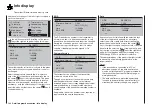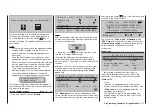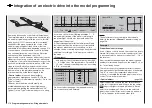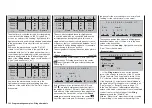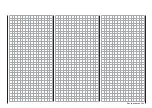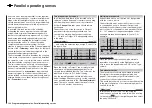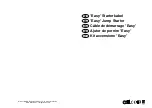
276
Programming examples - Winged models
Integration of an electric drive into the model programming
An electric drive can be controlled in different ways:
The simplest method to integrate one such drive into
the model programming is with the use of a throttle/
brake joystick (C1). However, since this is already
specifi ed for the brake system in the course of the
model programming described above, either the
switchable solution described beginning on page 279
or even the use of an alternative control is possible.
As a suitable alternative, one of the two 3-position
switches would be better than one of the
proportionals controls. However, either one of the two
side proportional rotary controls are also well suited
to activation of a motor without having to let go of the
joystick. An alternative would also be one of the two-
stage switches. Basically, whatever switch is used
should be located where it is within convenient reach.
Before we turn to the individual examples, it is
important must be noted that all inputs in the
»
Control adjust
« menu can be selectively
programmed as fl ight-phase specifi c ("PH" in the
"Type" column) or model memory specifi c ("GL" in the
"Type" column)!
However, since the drive should usually be
available depending on the current fl ight phase,
we recommend leaving the standard default "GL"
("global") in the "Type" column which your are using.
0%
+100%
I5
I6
I7
I8
Typ SEL
+100%
0.0 0.0
–
–time+
0%
+100%
+100%
0.0 0.0
0%
+100%
+100%
0.0 0.0
0%
+100%
+100%
0.0 0.0
GL
GL
GL
fr
---
fr
fr
fr
---
---
---
offset
GL
Nor mal
A common option in the following examples 1 … 5,
the automatic tracking of the elevator trimming in
the power fl ight, should also be mentioned at the
beginning of this section:
If it becomes apparent after the initial power fl ights
that the model must be continuously corrected with
the elevator while the motor is switched on, this
situation can be corrected by setting a free mixer and
adjusting it accordingly. For this purpose, switch to
the menu …
»Free mixers«
… and program one of the linear mixers, Linear MIX
1 … 8, or even one of the curve mixers, Curve MIX 9
… 12, from "channel controlling the motor" according
to "Ele", for example:
EL
LinearMIX 1
Typ
8
from
– Begr. +
??
??
??
??
??
??
––––
LinearMIX 2
LinearMIX 3
LinearMIX 4
LinearMIX 5
to
Adjust
––––
––––
??
??
––––
On its second screen page, the required – usually
low – correction value is entered:
8
Mix input
Offset
+
–
100
¼
O U
T P U
T
0%
EL
Linear MIX 1
+4%
SYM ASY
SET
STO
+4%
Note:
The adjustment of a curve mixer is described in
detail in the section »
Channel 1 curve
« starting on
page 128.
Example 1
Proportional control usage
If one of these controls is used, the connection is very
simple. Only the motor controller (speed control) has
to be connected to a free servo connection 5 … 16 of
the receiver.
Bear in mind that, depending on the model type and
number of aileron and fl ap servos, the output 2 + 5 or
6 + 7 are already linked.
Therefore connect your speed controller to the next
free input and assign the selected input – for example,
"Inp. 8" – to one of the transmitter's proportional
controls, for example the left-side proportional rotary
control. This is done in the menu …
»Control adjust«
(page 108)
Select the desired line with the
cd
selection keys
of the left or right touch pad. A tap on the the center
SET
key of the right touch pad will activate "Switch
and control assignment". Now move the selected
proportional control. After a short time, an entry, e.g.
"Cn2", will appear in the inverse video fi eld.
Summary of Contents for 32032
Page 1: ...33020 mc 20HoTT 2 en Programming Manual o Pro Pro mc 20 mc 20...
Page 15: ...15 For your notes...
Page 21: ......
Page 27: ...27 For your notes...
Page 41: ...41 For your notes...
Page 53: ...53 For your notes...
Page 59: ...59 For your notes...
Page 63: ...63 For your notes...
Page 93: ...93 For your notes...
Page 97: ...97 For your notes...
Page 141: ...141 How is a ight phase programmed...
Page 145: ...145 For your notes...
Page 155: ...155 For your notes...
Page 175: ...175 For your notes...
Page 203: ...203 For your notes...
Page 219: ...219 For your notes...
Page 253: ...253 For your notes...
Page 283: ...283 For your notes...
Page 321: ...321 For your notes...
Page 322: ...322 For your notes...
Page 323: ...323 For your notes...





